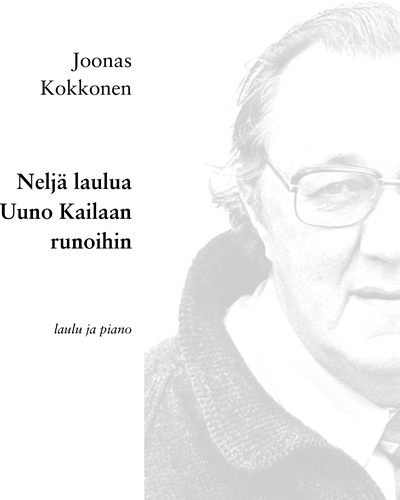
Joonas Kokkonen
9 pieces at nkodankoda sheet music library
over 100k editions from $14.99/month
Hassle-free. Cancel anytime.
available on
nkoda digital sheet music subscription


Editions
Annotate
Library
Perform
100k+ available Editions
More about Joonas Kokkonen
Joonas Kokkonen was one of the dominant figures of the post-war history of Finnish musical life. He was also a leading symphonist who, in addition to composing made a tremendous contribution to his field by serving in numerous important administrative capacities, such as the chairman of Teosto, the Finnish copyright bureau and the chairman of the Nordic Composers Council. Kokkonen was also professor of composition at the Sibelius Academy from 1959 until 1963. Kokkonen has come to be regarded as the spiritual successor to Sibelius while names such as Bach and Bartók have been proffed as his models. Following an early period of neoclassicism, he turned to 12-tone technique and on via his third symphony (1967) to free tonality. In the 1970s, especially, melody acquired an increasingly prominent position in his music. Above all Kokkonen is known for the opera The Last Temptations (Viimeiset kiusaukset, 1975). This main work by Kokkonen has won itself a place among one of the most succesful Finnish operas. He composed it during a period of 16 years, and the world premiere was at the Finnish National Opera in September 1975. Since then it has been staged hundreds of times. Kokkonen was not a particularly prolific composer. He first made a name for himself with the Neoclassical Piano Quintetin the 1950s. He wrote three weighty string quartets between 1959 and 1976. Beginning with chamber music, he did not progress to orchestral music until he was nearly 40. Music for String Orchestra (1957) marked his breakthrough as a major orchestral composer. Kokkonen composed four symphonies in all, and they offer an exciting view to Kokkonen’s stylistic development. The first two were written in 1960 and 1961 during Kokkonen’s dodecaphonic period. The third symphony (1967) starts his free tonal period.

Joonas Kokkonen sheets music on nkoda
Edition/Parts
Composer/Artist
Part
Source

Il paesaggio
Joonas Kokkonen
Ensemble
Fennica Gehrman

Four Songs to Lyrics by Uuno Kailas
Joonas Kokkonen
Voice & Piano
Fennica Gehrman

Pielavesi
Joonas Kokkonen
Piano
Fennica Gehrman

Sonata for Cello and Piano
Joonas Kokkonen
Cello & Piano
Fennica Gehrman

Paavo's Hymn
Joonas Kokkonen
Children's Chorus
Fennica Gehrman

Lehvillä Puiden
Joonas Kokkonen
Low Voice Chorus
Fennica Gehrman

Sub Rosa
Joonas Kokkonen
Voice & Piano
Fennica Gehrman

The Hades of the Birds
Joonas Kokkonen
Mezzo-soprano & Piano
Fennica Gehrman

Christmas Songs for Children
Joonas Kokkonen
Mixed Chorus
Fennica Gehrman
INSTITUTIONAL PARTNERS
PUBLISHERS PARTNERS
TESTIMONIALS
































